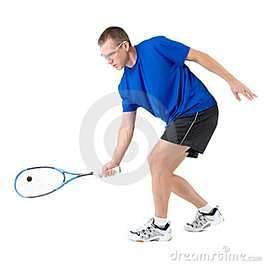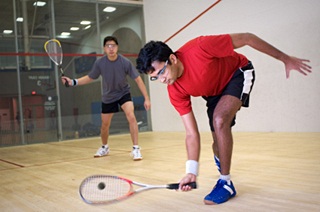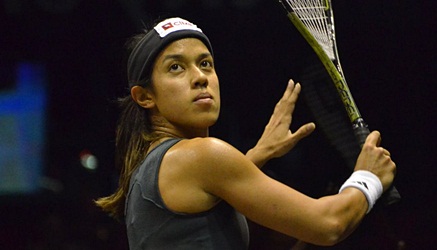What Shape Is Your Racket In?
No...we're not talking about whether or not your squash-racket frame is cracked, has a broken or missing string! What we are talking about is the shape of your racket-head as you prepare, swing and making contact with the ball...especially the latter!

To explain, we're going to take a "backward approach" in making an attempt to solving what could be a problem with your squash swing - and in particular, with being able to meet your objectives regarding accuracy and hitting your desired targets during solo and/or pair practices, or while playing games and/or matches.
In addition to taking a "backward approach," we're going to employ, (as mentioned in a previous article), a "slow "motion" learning philosophy. Slow motion learning speeds up learning for a number of reasons. For one, it increases your awareness of what you are actually trying to accomplish during the swing, i.e. preparation, swing, contact with the ball and follow-through to your desired target. Or...even in your movement, i.e. proper and exact foot-work placement and body position. It enhances the “feel” and a sense of “connection” with your body and/or squash racket.
Rather than the normal approach, starting with the preparation of the swing, we're going to start with the actual hitting "moment," using a backward approach. Of course, the shape of your racket first depends on the grip. The "V" formed by your thumb and forefinger should be aligned with the left/inside "edge" (not the top of) the racket frame, which is called a (sightly) continental grip. This is in contrast with the eastern or western grip used while playing tennis. Gripping the racket with this (continental) grip will result in the racket-face being slightly open on the forehand side.
So...set yourself up as if you were at the precise moment of making contact with the ball, i.e. photo above. Be aware of exactly what the position and "shape" of your racket face is (your feet and body as well) at that very moment. Doesn't it make sense that if this is the shape of your racket (slightly open) at the hitting "moment," shouldn't that same "shape" be maintained throughout the swing, beginning with the preparation, proceeding through the three stages of the swing, i.e. short, compact and full...but in reverse!?
Employing the backward approach, once you've set yourself up at the hitting moment, keeping your wrist cocked, the shaft of the racket at a roughly 45 degree angle to your forearm and parallel with the floor, bring the racket-head (not the arm) back, setting up a short swing preparation. Remember that the open-face "shape" of the racket-head should be maintained.
From here, lift your arm up and away from your body to where your hand is about head high, elbow pointing down. This is commonly known as the "compact" swing preparation. Again, the "shape" of the racket-head should still be maintained.
For a full (international forehand) swing, (if time permits) lift the bent elbow (slowly at first) further away from your body, creating a good deal of space between your upper-arm and torso. Once doing this, stop and hold. If you look up at the racket-head, you should still be able to see the strings on the hitting surface of the racket face. If not, you've changed the "shape," of your racket and/or grip, requiring you to adjust it on the downswing and to the hitting moment. Why do that!?
With the game of squash being so "reactive," you really don't have the time and shouldn't need to "adjust" or change the "shape" of your racket-head face from the beginning of a full, compact or short swing phase to the moment of contact with the ball.
And why the open-face or slightly continental "shape" of the racket-head? Well, if you think of having to "scrape" a ball off the floor which is only six inches high, with a flat (or closed) "shape" of the racket face, you could easily end up hitting the tin.
Likewise, if you're able to maintain that "shape" of the racket-head while attempting to volley, "scraping" the ball off the side wall, (service returns, etc.) that "shape" will allow you to do it efficiently - causing back/side-spin, often resulting in the ball hugging the side wall when rebounding from the front wall.
All the above applies to the backhand side as well. All that needs to be done is to make sure the "cocked" wrist is maintained, (not "rolled) which will result in the "shape" of the racket face being identical to that of the forehand throughout the swing. Note Nicol David's backhand preparation, i.e. wrist cocked, with the racket face hitting surface strings visible.
Again, once taking the backward approach on both the forehand and backhand, all the way to a full preparation, look up at the racket-face. Do you see the strings on the hitting surface of the racket? If not....well!
So...the next time you find yourself missing your target goals, give this racket "shape" backward and slow motion approach a try.
Article reprinted courtesy of the Daily Squash Report
|
|
